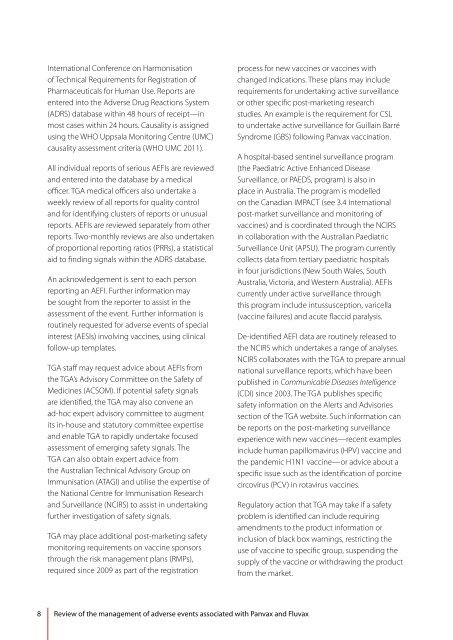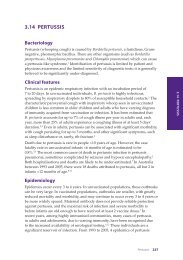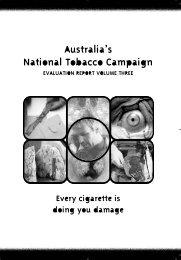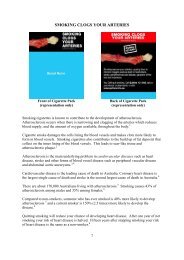Review of the management of adverse effects associated with ...
Review of the management of adverse effects associated with ...
Review of the management of adverse effects associated with ...
Create successful ePaper yourself
Turn your PDF publications into a flip-book with our unique Google optimized e-Paper software.
International Conference on Harmonisation<br />
<strong>of</strong> Technical Requirements for Registration <strong>of</strong><br />
Pharmaceuticals for Human Use. Reports are<br />
entered into <strong>the</strong> Adverse Drug Reactions System<br />
(ADRS) database <strong>with</strong>in 48 hours <strong>of</strong> receipt—in<br />
most cases <strong>with</strong>in 24 hours. Causality is assigned<br />
using <strong>the</strong> WHO Uppsala Monitoring Centre (UMC)<br />
causality assessment criteria (WHO UMC 2011).<br />
All individual reports <strong>of</strong> serious AEFIs are reviewed<br />
and entered into <strong>the</strong> database by a medical<br />
<strong>of</strong>ficer. TGA medical <strong>of</strong>ficers also undertake a<br />
weekly review <strong>of</strong> all reports for quality control<br />
and for identifying clusters <strong>of</strong> reports or unusual<br />
reports. AEFIs are reviewed separately from o<strong>the</strong>r<br />
reports. Two-monthly reviews are also undertaken<br />
<strong>of</strong> proportional reporting ratios (PRRs), a statistical<br />
aid to finding signals <strong>with</strong>in <strong>the</strong> ADRS database.<br />
An acknowledgement is sent to each person<br />
reporting an AEFI. Fur<strong>the</strong>r information may<br />
be sought from <strong>the</strong> reporter to assist in <strong>the</strong><br />
assessment <strong>of</strong> <strong>the</strong> event. Fur<strong>the</strong>r information is<br />
routinely requested for <strong>adverse</strong> events <strong>of</strong> special<br />
interest (AESIs) involving vaccines, using clinical<br />
follow-up templates.<br />
TGA staff may request advice about AEFIs from<br />
<strong>the</strong> TGA’s Advisory Committee on <strong>the</strong> Safety <strong>of</strong><br />
Medicines (ACSOM). If potential safety signals<br />
are identified, <strong>the</strong> TGA may also convene an<br />
ad-hoc expert advisory committee to augment<br />
its in-house and statutory committee expertise<br />
and enable TGA to rapidly undertake focused<br />
assessment <strong>of</strong> emerging safety signals. The<br />
TGA can also obtain expert advice from<br />
<strong>the</strong> Australian Technical Advisory Group on<br />
Immunisation (ATAGI) and utilise <strong>the</strong> expertise <strong>of</strong><br />
<strong>the</strong> National Centre for Immunisation Research<br />
and Surveillance (NCIRS) to assist in undertaking<br />
fur<strong>the</strong>r investigation <strong>of</strong> safety signals.<br />
TGA may place additional post-marketing safety<br />
monitoring requirements on vaccine sponsors<br />
through <strong>the</strong> risk <strong>management</strong> plans (RMPs),<br />
required since 2009 as part <strong>of</strong> <strong>the</strong> registration<br />
process for new vaccines or vaccines <strong>with</strong><br />
changed indications. These plans may include<br />
requirements for undertaking active surveillance<br />
or o<strong>the</strong>r specific post-marketing research<br />
studies. An example is <strong>the</strong> requirement for CSL<br />
to undertake active surveillance for Guillain Barré<br />
Syndrome (GBS) following Panvax vaccination.<br />
A hospital-based sentinel surveillance program<br />
(<strong>the</strong> Paediatric Active Enhanced Disease<br />
Surveillance, or PAEDS, program) is also in<br />
place in Australia. The program is modelled<br />
on <strong>the</strong> Canadian IMPACT (see 3.4 International<br />
post-market surveillance and monitoring <strong>of</strong><br />
vaccines) and is coordinated through <strong>the</strong> NCIRS<br />
in collaboration <strong>with</strong> <strong>the</strong> Australian Paediatric<br />
Surveillance Unit (APSU). The program currently<br />
collects data from tertiary paediatric hospitals<br />
in four jurisdictions (New South Wales, South<br />
Australia, Victoria, and Western Australia). AEFIs<br />
currently under active surveillance through<br />
this program include intussusception, varicella<br />
(vaccine failures) and acute flaccid paralysis.<br />
De-identified AEFI data are routinely released to<br />
<strong>the</strong> NCIRS which undertakes a range <strong>of</strong> analyses.<br />
NCIRS collaborates <strong>with</strong> <strong>the</strong> TGA to prepare annual<br />
national surveillance reports, which have been<br />
published in Communicable Diseases Intelligence<br />
(CDI) since 2003. The TGA publishes specific<br />
safety information on <strong>the</strong> Alerts and Advisories<br />
section <strong>of</strong> <strong>the</strong> TGA website. Such information can<br />
be reports on <strong>the</strong> post-marketing surveillance<br />
experience <strong>with</strong> new vaccines—recent examples<br />
include human papillomavirus (HPV) vaccine and<br />
<strong>the</strong> pandemic H1N1 vaccine—or advice about a<br />
specific issue such as <strong>the</strong> identification <strong>of</strong> porcine<br />
circovirus (PCV) in rotavirus vaccines.<br />
Regulatory action that TGA may take if a safety<br />
problem is identified can include requiring<br />
amendments to <strong>the</strong> product information or<br />
inclusion <strong>of</strong> black box warnings, restricting <strong>the</strong><br />
use <strong>of</strong> vaccine to specific group, suspending <strong>the</strong><br />
supply <strong>of</strong> <strong>the</strong> vaccine or <strong>with</strong>drawing <strong>the</strong> product<br />
from <strong>the</strong> market.<br />
8<br />
<strong>Review</strong> <strong>of</strong> <strong>the</strong> <strong>management</strong> <strong>of</strong> <strong>adverse</strong> events <strong>associated</strong> <strong>with</strong> Panvax and Fluvax







